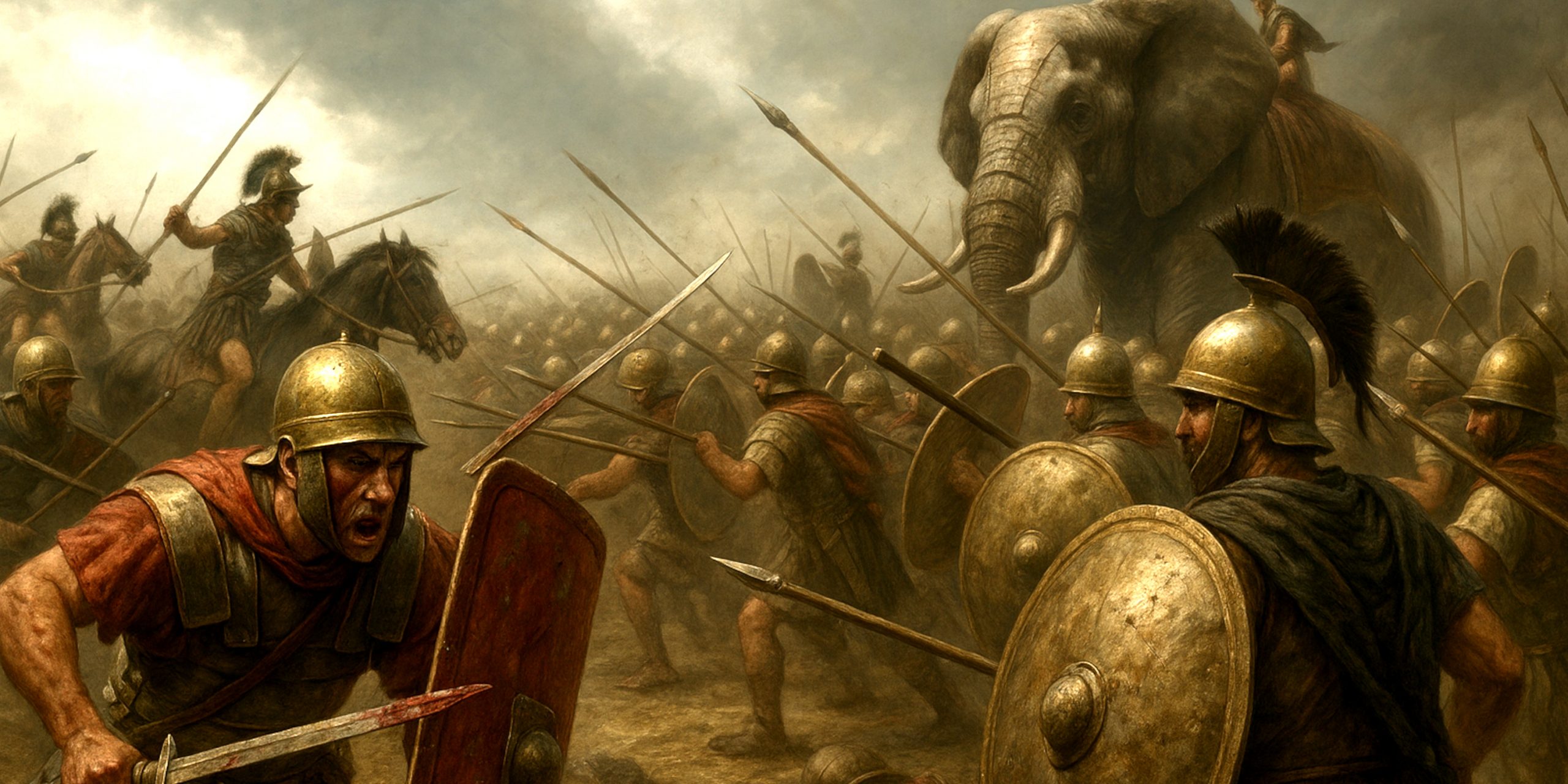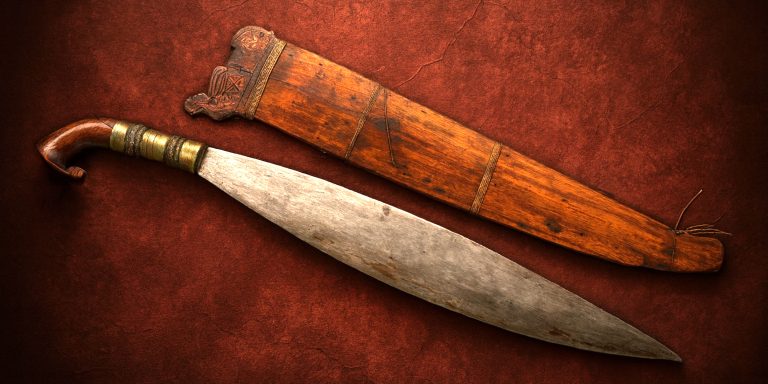
The Battle of Heraclea, fought in 280 BC near the Siris River in southern Italy, marked the first major engagement between the rising Roman Republic and King Pyrrhus of Epirus. It was an encounter that introduced the Romans to something they had never faced before: elephants on the battlefield. It also gave birth to one of history’s most famous phrases, the “Pyrrhic victory.”
Heraclea was both a triumph and a warning. For Pyrrhus, it was proof that his Greek-style phalanx could match Rome’s legions in open combat. For the Romans, it was a harsh education in the cost of expansion and the need to adapt.
Historical Background
When the Greek city of Tarentum (modern Taranto) found itself at odds with Rome, it called upon Pyrrhus, a relative of Alexander the Great and one of the most ambitious kings of his era. He saw the conflict as a chance to carve a Hellenistic empire in Italy and perhaps beyond.
Rome, never one to tolerate challenges, responded by mobilising its legions to punish Tarentum and its allies. The meeting at Heraclea was inevitable.
Forces
Below is a breakdown of the two armies that met near the Siris River. Exact numbers vary by source, but ancient accounts by Plutarch and Dionysius of Halicarnassus provide the general scale.
| Side | Leader | Estimated Strength | Composition |
|---|---|---|---|
| Kingdom of Epirus (and allies) | King Pyrrhus of Epirus | 25,000–30,000 men | Phalanx infantry, Thessalian cavalry, Tarentine allies, 20 war elephants |
| Roman Republic | Consul Publius Valerius Laevinus | 35,000–40,000 men | 2 Roman legions with allied Italian infantry, cavalry, skirmishers |
Leaders and Troop Composition
Epirote Army
- Commander: King Pyrrhus I of Epirus
- Core Infantry: Macedonian-style phalanx armed with sarissas (pikes over 5 metres long)
- Allied Infantry: Tarentine hoplites, light infantry (peltasts)
- Cavalry: Thessalian heavy horse, renowned for their discipline and shock charge
- Elephants: Around 20 Indian elephants, trained for battle and armoured with bronze plates
- Sword Types Used:
Roman Army
- Commander: Consul Publius Valerius Laevinus
- Core Infantry: Manipular legions composed of hastati, principes, and triarii
- Allies: Campanian, Lucanian, and Samnite auxiliaries
- Cavalry: Roman equites and Italian allies, fewer in number than Pyrrhus’s
- Sword Types Used:
- Gladius Hispaniensis – early variant of the Roman short sword
- Pugio – a dagger worn by officers and some soldiers as a last resort
Arms and Armour
| Army | Armour | Primary Weapons | Shields |
|---|---|---|---|
| Epirote (Greek-style) | Bronze breastplates, crested helmets, greaves | Sarissa, kopis, xiphos | Large round aspis shields |
| Roman | Chainmail or bronze cuirass, Montefortino helmets | Pilum (javelin), gladius | Large oval scutum shields |
The Roman scutum offered superior coverage but was awkward in close formation against the phalanx’s dense wall of pikes. The Epirotes, however, struggled to maintain cohesion on broken terrain, a recurring problem for Greek armies fighting in Italy.
The Battle
The two forces met near the Siris River. Pyrrhus attempted to delay crossing, but when the Romans forced the ford, he deployed his phalanx to meet them.
The first stages were evenly matched. Roman principes managed to push parts of the Epirote line back, while Pyrrhus’s Thessalian cavalry repeatedly checked Roman flanking attempts. The decisive moment came when Pyrrhus unleashed his elephants.
The beasts, never before seen by Roman soldiers or horses, caused chaos in the ranks. The Roman cavalry fled, trampling infantry in panic. Pyrrhus seized the opportunity, ordering a full advance. The Roman line collapsed, and Laevinus was forced to retreat.
Outcome
Pyrrhus technically won the day, but at a cost he could scarcely afford. Around 7,000 Romans and 4,000 Epirotes lay dead by sunset. Pyrrhus held the field, yet his losses among veteran officers were crippling.
As Plutarch later recorded Pyrrhus’s own words after the battle:
“If we are victorious in one more battle with the Romans, we shall be utterly ruined.”
Archaeology
The site near modern Heraclea (Policoro, Basilicata) has yielded fragments of weaponry and bronze fittings, consistent with early Hellenistic military presence. Excavations have found spearheads, arrowheads, and Greek-style armour plates, though no clear evidence of elephant remains has survived.
Traces of Roman encampments nearby suggest that Laevinus’s army established a fortified position before engaging. Amphorae and coin hoards bearing Pyrrhus’s image have also been uncovered, hinting at his short-lived occupation of the area.
Battle Timeline
| Time | Event |
|---|---|
| Morning, 280 BC | Roman scouts engage Tarentine outposts near the Siris River. |
| Late morning | Laevinus orders a crossing; initial skirmishes break out. |
| Midday | Pyrrhus deploys his phalanx and Thessalian cavalry; initial success for Romans on the left flank. |
| Afternoon | Pyrrhus releases elephants, causing panic among Roman cavalry. |
| Late afternoon | Roman lines collapse; Laevinus withdraws across the river. |
| Evening | Pyrrhus holds the field but suffers significant officer casualties. |
Legacy
Heraclea was the first of Pyrrhus’s two major victories against Rome, the second being at Asculum the following year. Yet both came at immense cost. The battle demonstrated the tactical brilliance of Hellenistic warfare but also its fragility against Rome’s manpower and adaptability.
For the Romans, Heraclea was a shock, but also a lesson. Within a generation, they would learn to counter elephants, exploit terrain, and dismantle the phalanx system.
As a historian, I find it hard not to admire Pyrrhus’s audacity. He was a man who tried to out-Alexander Alexander, only to be ground down by the dull but deadly efficiency of Roman persistence.
The Seven Swords Takeaway
The Battle of Heraclea stands as one of those curious turning points where innovation meets tradition and both sides walk away claiming victory, yet only one wins the future. Pyrrhus may have dazzled Italy with elephants and Macedonian pageantry, but Rome walked away with something far more useful, experience.
Watch the documentary:



